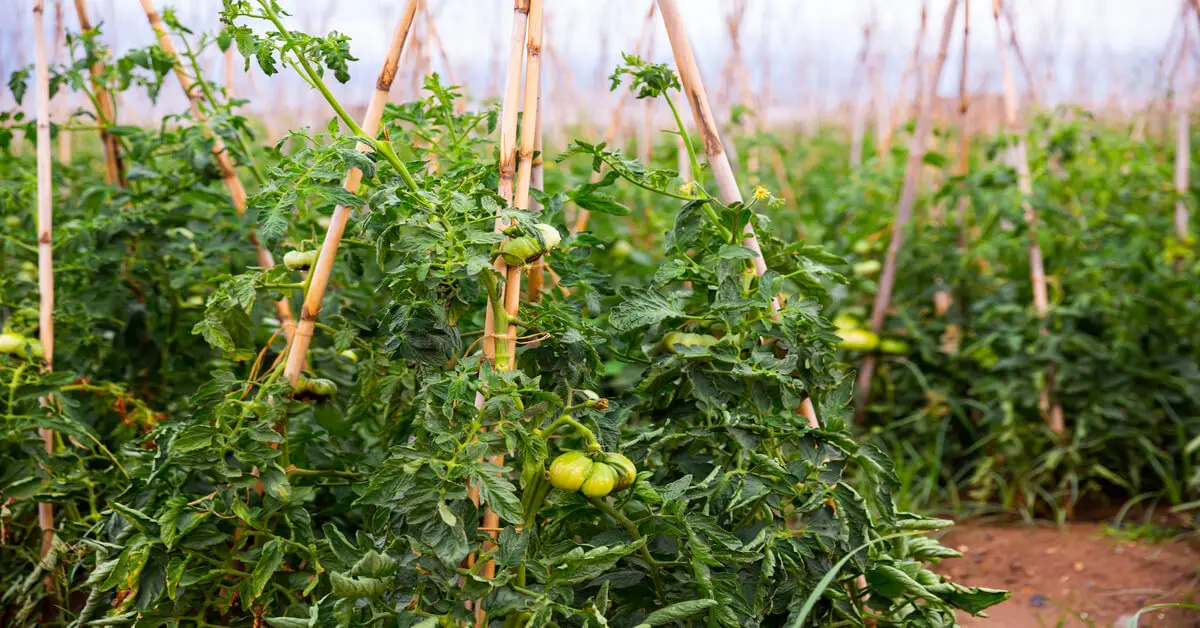Although tomatoes may sprawl freely in the garden, most gardeners will cage, trellis, stake, or secure their growing tomatoes to a vertical support structure to keep them off the ground, protect them from damage, and save space.
However, if you’re planting multiple tomato plants in a garden, how much row spacing or how far apart should you plant tomato rows?
The complex answer is this depends on the cultivar selected, the growing conditions, how much space you have, and what type of caging or vertical support system you prefer.
The simple answer is you should give your vertically grown tomatoes at least 15 inches (40+ cm) of space between plants within a row and at least 3-4 feet (90-120 cm) between rows.
For bush or indeterminate types, consider giving them a little more space between plants (up to 24 inches or 60 cm) to allow for the extra horizontal spread and caging structure.
Why Tomatoes Need Space
Spacing for planting tomatoes affects everything from fruit size and yields to flavor.
Of course, other factors affecting fruit yield and flavor are also at play, such as cultivar chosen, fruit decay, diseases, heat, growing conditions, insects, etc.
Growing tomatoes too close together makes applying crop management practices such as proper airflow, chemical sprays, and weeding difficult. Without these practices, tomatoes are more likely to encounter diseases and pests.
Planting tomatoes too close together also results in increased competition for light, nutrients, and water, reducing your tomato’s fruit size, the number of fruits per plant, and the flavor intensity of each fruit.
Ideal Spacing for Tomato Plants
Rutgers University researchers suggest spacing tomato plants 3-4 feet (90-120 cm) between rows and at least 1.5-2 feet (45-60 cm) apart within rows for staked tomatoes.
For sprawling tomatoes, they suggested increasing the spacing for tomato plants within rows to at least 3 feet (90 cm). [1] Empirical studies also back this up.
One study of tomato plants grown at various distances apart (70, 80, 90, and 100 cm between rows and 20, 30, and 40 cm within rows) showed that fruit length, width, and yields generally increased with greater distances.
Tomatoes planted further apart between and within rows produced better canopy growth (higher photosynthesis) and higher total soluble solids (which contribute to better flavor).
The authors concluded that the tomato cultivars planted 15 inches (40 cm) between plants and 3 feet (90 cm) between rows produced the highest yields and flavor components. [2]
One interesting point from the study showed that spacing rows too far apart (at 100 cm or more) reduced marketable yields due to sunburn and sun overexposure.
Try to give your plants at least 15 inches (40 cm) between plants within rows, but avoid spacing rows more than 3 feet (90 cm) apart if your area is prone to intense sunlight. Spacing not too far apart will give your tomatoes some necessary shading in high heat.
While tomatoes adore the sun, intense heat can lead to sunburn and other problems, such as tomato rot, uneven ripening, curling leaves, and blossom drop.
Of course, more than space alone is needed to affect tomato quality and yields, though the consensus is that tomatoes do not like overcrowding.
Indeterminate vs. Determinate Type Spacing
Tomatoes are also typically classified into determinate vs. indeterminate (or bushing vs. vining) types, and which type you grow also affects the spacing you should give them.
While indeterminate tomatoes can grow up to 20-30 feet long, they are often pruned and secured to vertical support systems such as stakes or ropes, allowing them to conserve horizontal space.
Most gardeners advise against growing indeterminate tomatoes without vertical support, as the sprawl becomes uncontrollable, leading to pests, diseases, and damaged fruits.
For bushing or determinate tomatoes, consider giving them extra sprawling and cage space (up to 60 cm or 24 inches) between plants within a row and the same 3-4 feet (90-120 cm) between rows.
Tomato Planting Structures and Spacing

The amount of spacing needed when planting tomatoes also depends on the type of support structure you plan to create.
Most gardeners will provide a vertical support structure (e.g., staking, roping, overhead suspension, teepee, Florida Weaves, etc.) for indeterminate types, which conserves space and allows for companion crop growing.
Other gardeners prefer to plant determinate types in cages, which require more spacing between the cages.
Another popular tomato growing method, the Japanese Ring, involves planting 3-4 tomato seedlings outside the edge of a 3-feet diameter wire ring filled with nutrient-rich organic matter in a center feeder pile.
This method produces tomatoes with stronger roots and better nutrient uptake, resulting in potentially greater yields.
Of course, you can also grow tomatoes in containers, grow bags, or on raised garden beds, which may help with soil quality, spacing, and drainage issues.
References:
[1] Reiners, S., & Nitzsche, P. (2021, January). Growing Tomatoes in the Home Garden. Rutgers University, New Jersey Agriculture Experiment Station. https://njaes.rutgers.edu/fs678/.
[2] Assefa, W., Tesfaye, B., & Dessalegn, L. (2015). Influence of inter and intra-rows spacing on yield and yield components of tomato cultivars. Ethiopian Journal of Agricultural Sciences, 25, 71-81.

